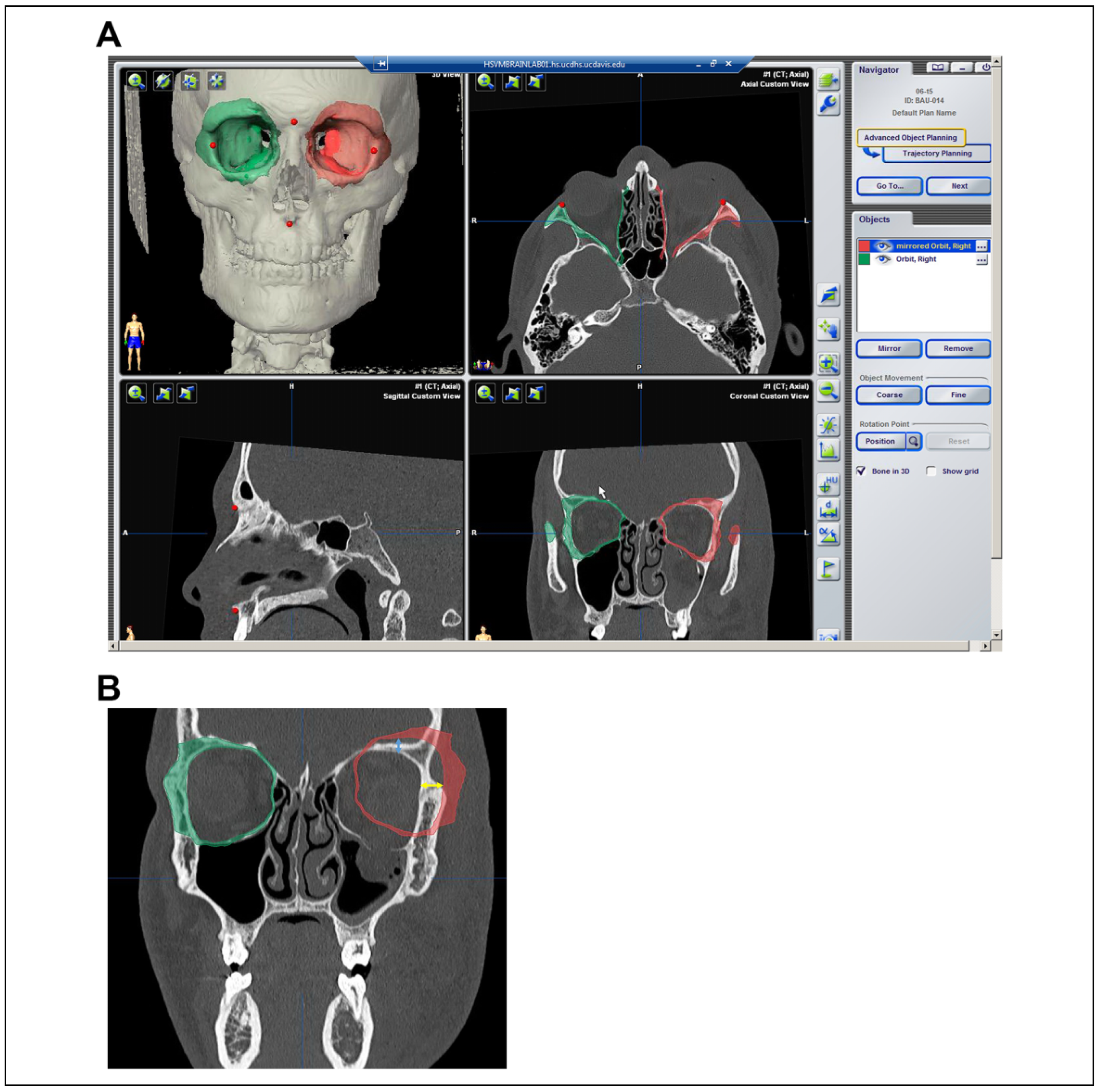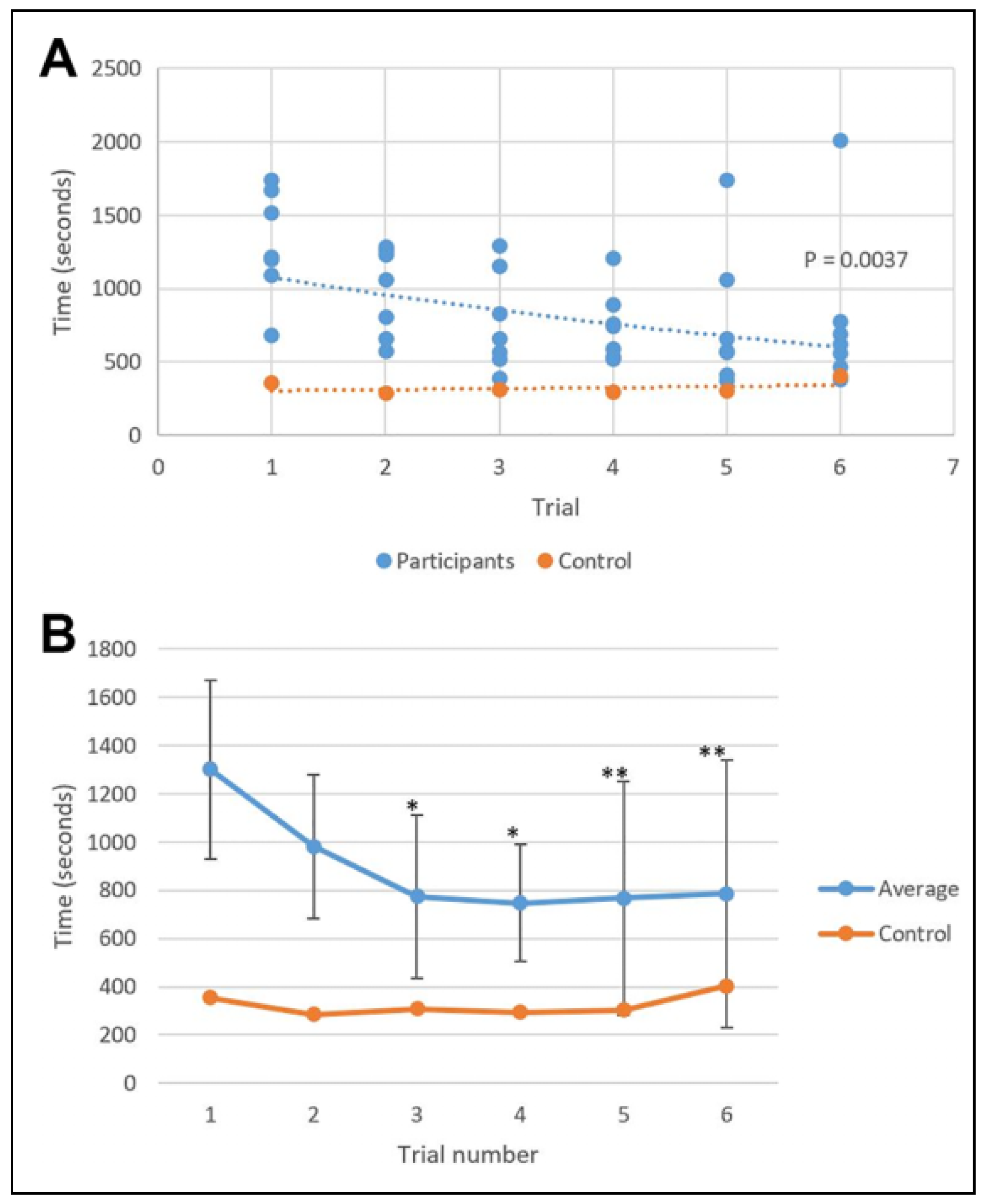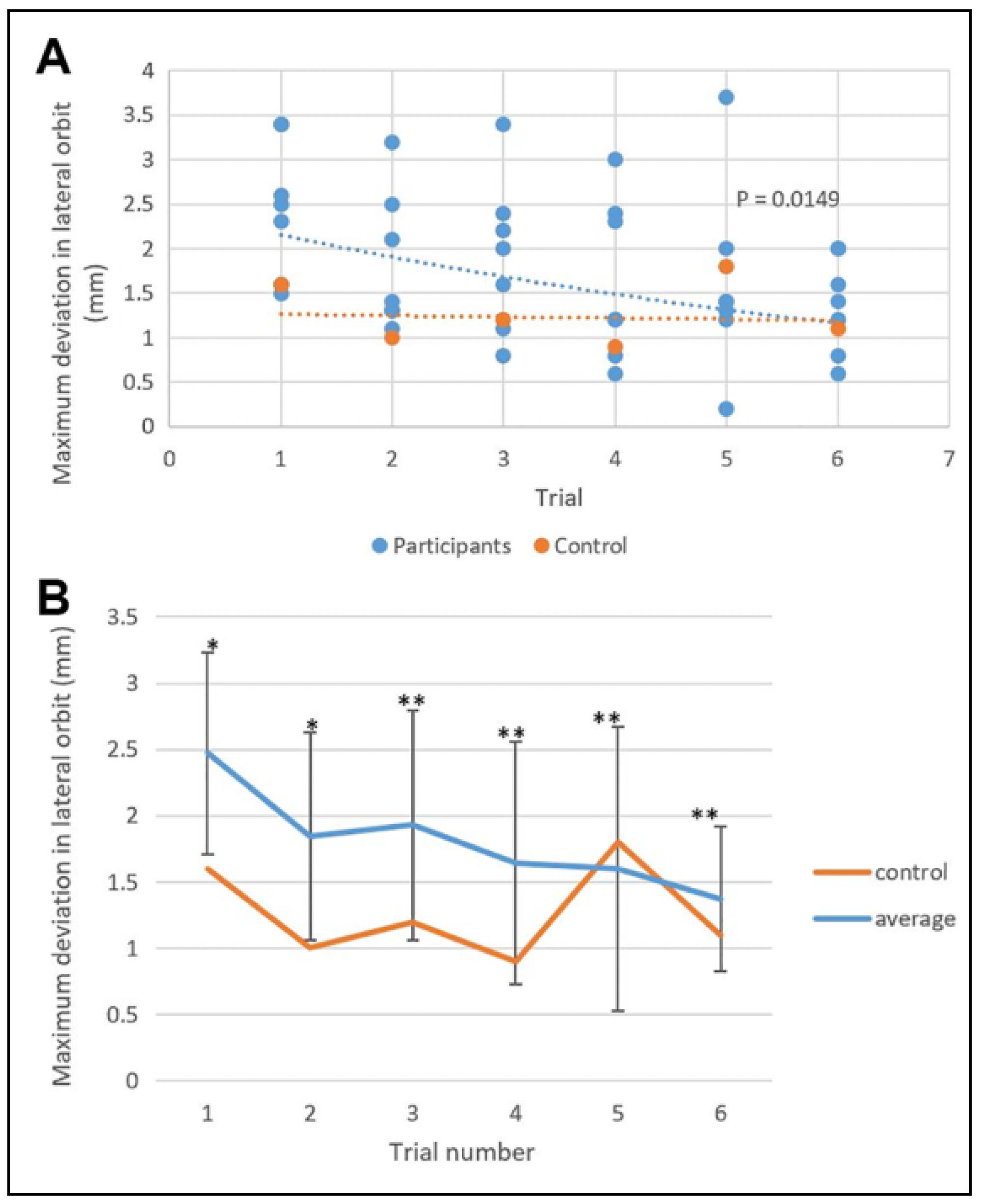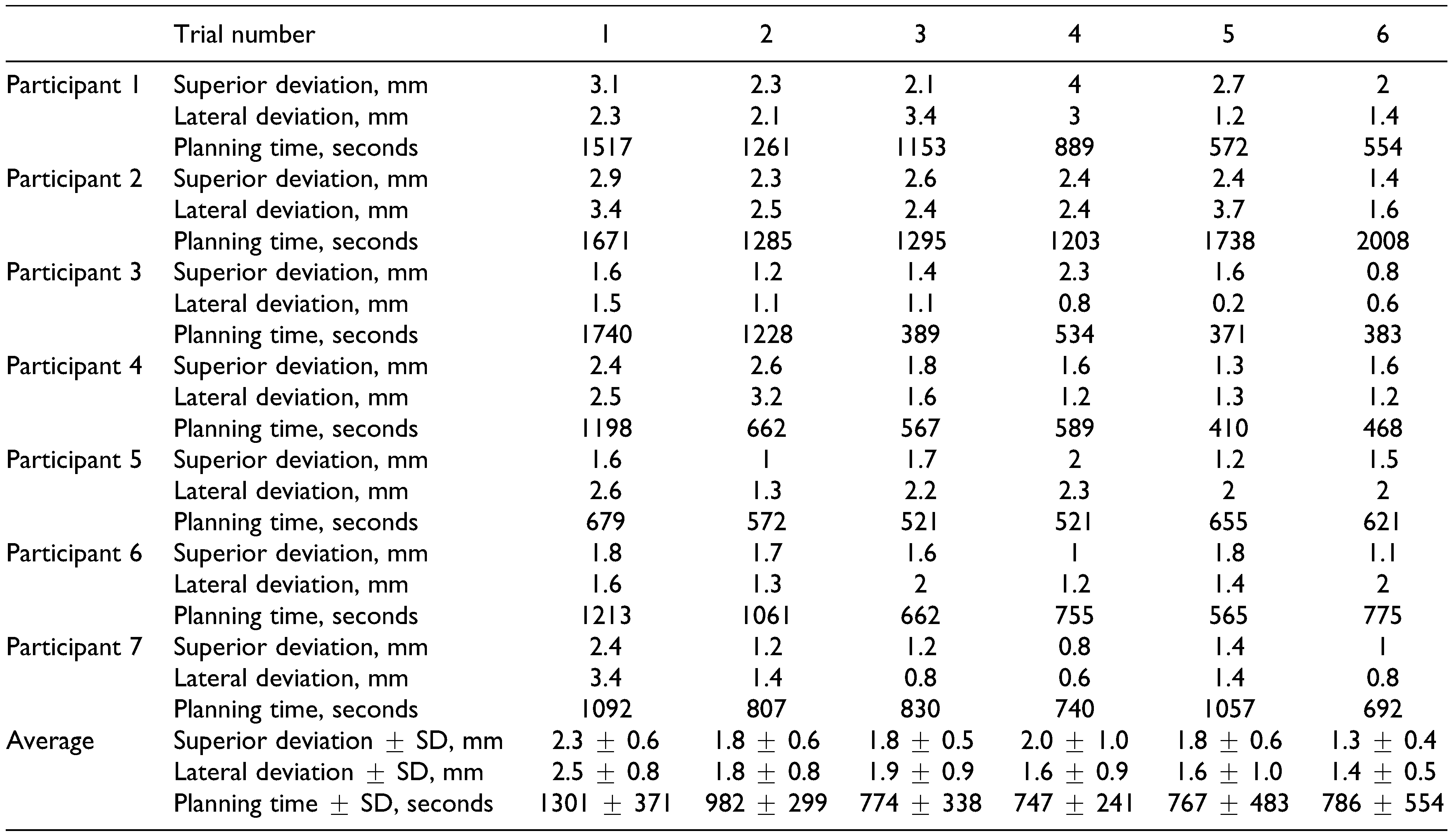Assessment of the Learning Curve for Virtual Surgical Planning in Orbital Fractures
Abstract
Introduction
Materials and Methods
Study Design
Data Analysis
Results
Discussion
Conclusion
Funding
Conflicts of Interest
References
- Essig, H.; Dressel, L.; Rana, M.; et al. Precision of posttraumatic primary orbital reconstruction using individually bent titanium mesh with and without navigation: A retrospective study. Head Face Med. 2013, 9, 18. [Google Scholar] [PubMed]
- Strong, E.B.; Fuller, S.C.; Wiley, D.F.; Zumbansen, J.; Wilson, M.D.; Metzger, M.C. Preformed vs. intraoperative bending of titanium mesh for orbital reconstruction. Otolaryngol Head Neck Surg. 2013, 149, 60–66. [Google Scholar] [PubMed]
- Bell, R.B.; Markiewicz, M.R. Computer-assisted planning, stereolithographic modeling, and intraoperative navigation for complex orbital reconstruction: A descriptive study in a preliminary cohort. J Oral Maxillofac Surg. 2009, 67, 2559–2570. [Google Scholar] [CrossRef] [PubMed]
- Kirke, D.N.; Owen, R.P.; Carrao, V.; Miles, B.A.; Kass, J.I. Using 3D computer planning for complex reconstruction of mandibular defects. Cancers Head Neck. 2016, 1, 17. [Google Scholar] [CrossRef] [PubMed]
- Zweifel, D.F.; Simon, C.; Hoarau, R.; Pasche, P.; Broome, M. Are virtual planning and guided surgery for head and neck reconstruction economically viable? J Oral Maxillofac Surg 2015, 73, 170–175. [Google Scholar] [PubMed]
- Efanov, J.I.; Roy, A.A.; Huang, K.N.; Borsuk, D.E. Virtual surgical planning: The pearls and pitfalls. Plast Reconstr Surg Glob Open. 2018, 6, e1443. [Google Scholar] [CrossRef] [PubMed]
- Bly, R.A.; Chang, S.H.; Cudejkova, M.; Liu, J.J.; Moe, K.S. Computer-guided orbital reconstruction to improve outcomes. JAMA Facial Plast Surg. 2013, 15, 113–120. [Google Scholar] [CrossRef] [PubMed]
- Blumer, M.; Gander, T.; Kruse Gujer, A.; Seifert, B.; Rucker, M.; Lubbers, H.T. Influence of mirrored computed tomograms on decision-making for revising surgically treated orbital floor fractures. J Oral Maxillofac Surg. 2015, 73, 1982.e1981-1989. [Google Scholar]
- Day, K.M.; Phillips, P.M.; Sargent, L.A. Correction of a posttraumatic orbital deformity using three-dimensional modeling, virtual surgical planning with computer-assisted design, and three-dimensional printing of custom implants. Craniomaxillofac Trauma Reconstr. 2018, 11, 78–82. [Google Scholar] [CrossRef] [PubMed]
- Vehmeijer, M.; van Eijnatten, M.; Liberton, N.; Wolff, J. A novel method of Orbtial floor reconstruction using virtual planning, 3-dimensional printing, and autologous bone. J Oral Maxillofac Surg. 2016, 74, 1608–1612. [Google Scholar] [CrossRef] [PubMed]
- Rodby, K.A.; Turin, S.; Jacobs, R.J.; et al. Advances in oncologic head and neck reconstruction: Systematic review and future considerations of virtual surgical planning and computer aided design/computer aided modeling. J Plast Reconstr Aesthet Surg. 2014, 67, 1171–1185. [Google Scholar] [CrossRef] [PubMed]
- Resnick, C.M.; Inverso, G.; Wrzosek, M.; Padwa, B.L.; Kaban, L.B.; Peacock, Z.S. Is there a difference in cost between standard and virtual surgical planning for orthognathic surgery? J Oral Maxillofac Surg. 2016, 74, 1827–1833. [Google Scholar] [PubMed]
- Mendez, B.M.; Chiodo, M.V.; Patel, P.A. Customized “In-Office” three-dimensional printing for virtual surgical planning in craniofacial surgery. J Craniofac Surg. 2015, 26, 1584–1586. [Google Scholar] [CrossRef] [PubMed]




 |
© 2020 by the author. The Author(s) 2020.
Share and Cite
Hsieh, T.-y.; Said, M.; Dedhia, R.D.; Timbang, M.R.; Steele, T.O.; Strong, E.B. Assessment of the Learning Curve for Virtual Surgical Planning in Orbital Fractures. Craniomaxillofac. Trauma Reconstr. 2020, 13, 186-191. https://doi.org/10.1177/1943387520923940
Hsieh T-y, Said M, Dedhia RD, Timbang MR, Steele TO, Strong EB. Assessment of the Learning Curve for Virtual Surgical Planning in Orbital Fractures. Craniomaxillofacial Trauma & Reconstruction. 2020; 13(3):186-191. https://doi.org/10.1177/1943387520923940
Chicago/Turabian StyleHsieh, Tsung-yen, Mena Said, Raj D. Dedhia, Mary Roz Timbang, Toby O. Steele, and Edward Bradley Strong. 2020. "Assessment of the Learning Curve for Virtual Surgical Planning in Orbital Fractures" Craniomaxillofacial Trauma & Reconstruction 13, no. 3: 186-191. https://doi.org/10.1177/1943387520923940
APA StyleHsieh, T.-y., Said, M., Dedhia, R. D., Timbang, M. R., Steele, T. O., & Strong, E. B. (2020). Assessment of the Learning Curve for Virtual Surgical Planning in Orbital Fractures. Craniomaxillofacial Trauma & Reconstruction, 13(3), 186-191. https://doi.org/10.1177/1943387520923940




